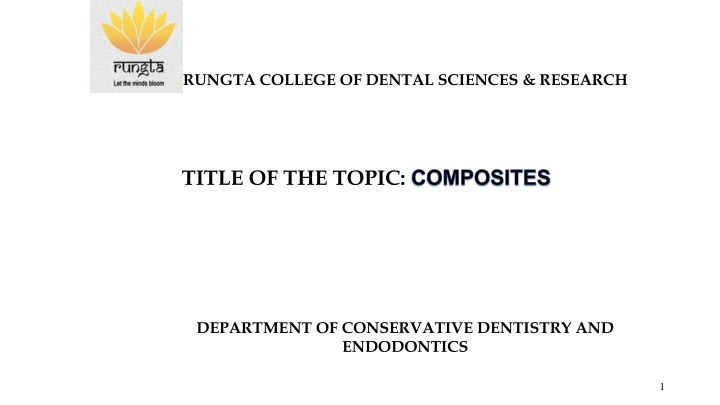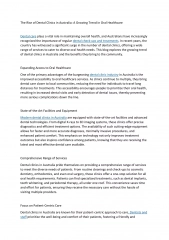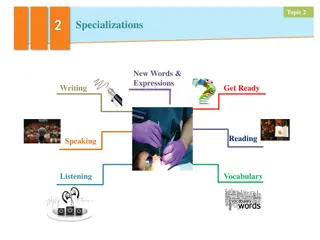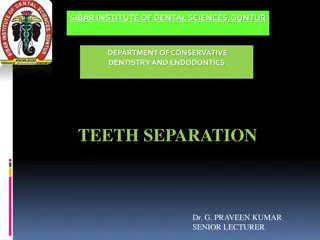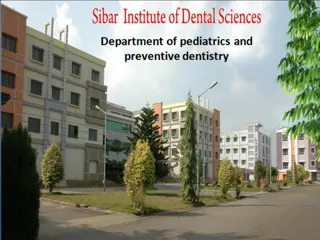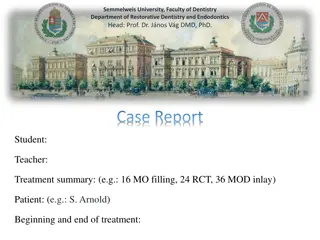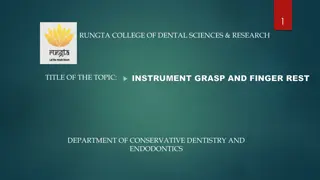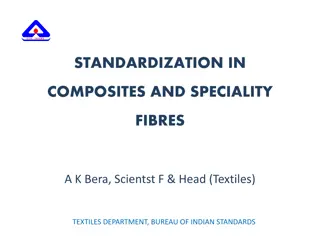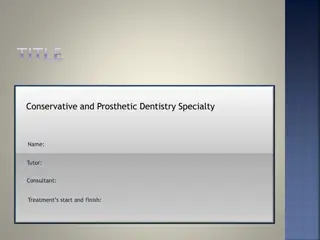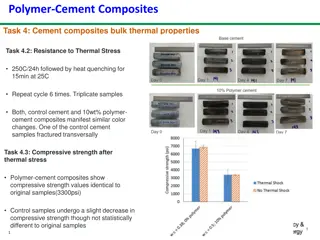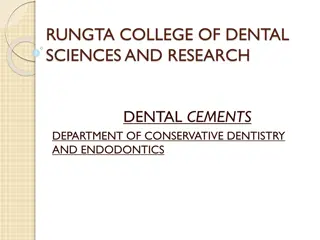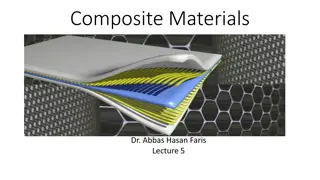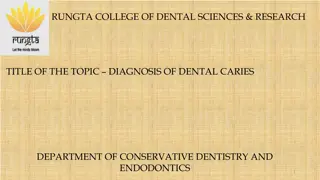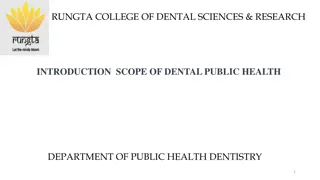Composites in Conservative Dentistry and Endodontics
In the field of dental sciences, the use of composites plays a vital role in Conservative Dentistry and Endodontics. This Title represents the blend of modern materials and techniques in dental restorations, focusing on preserving natural tooth structure. It emphasizes the importance of using composite materials for durable and aesthetically pleasing results in dental treatments.
Download Presentation

Please find below an Image/Link to download the presentation.
The content on the website is provided AS IS for your information and personal use only. It may not be sold, licensed, or shared on other websites without obtaining consent from the author.If you encounter any issues during the download, it is possible that the publisher has removed the file from their server.
You are allowed to download the files provided on this website for personal or commercial use, subject to the condition that they are used lawfully. All files are the property of their respective owners.
The content on the website is provided AS IS for your information and personal use only. It may not be sold, licensed, or shared on other websites without obtaining consent from the author.
E N D
Presentation Transcript
RUNGTA COLLEGE OF DENTAL SCIENCES & RESEARCH TITLE OF THE TOPIC: COMPOSITES DEPARTMENT OF CONSERVATIVE DENTISTRY AND ENDODONTICS 1
Specific learning Objectives Specific learning Objectives At the end of this presentation the learner is expected to know Core areas* H Domain ** Category # Definition, indication, contraindication, composition, Classification Cognitive Must know Cavity preparation, clinical procedure, bonding agent Psychomotor Nice to know Methods of polymerization Affective Desire to know *Subtopic of importance ** Cognitive, Psychomotor or Affective # Must know , Nice to know & Desire to know 2
Table of Content What are composites Definitions Indications Contraindications Advantages Disadvantages of dental composites. Components of composites
COMPONENTS OF THE COMPOSITES
RESIN MATRIX- a plastic resin material that forms a continuous phase and binds the filler particles. Eg BIS GAMA, TEGDEMA FILLER- reinforcing particles and fibers that are dispersed in the matrix. example Silica Quartz
COUPLING AGENTS- bonding agent that promotes adhesion between filler and resin matrix. Eg :- silane INHIBITORS:- added to minimize or prevent spontaneous or accidental polymerization of monomers. Eg :- butylated hydroxytoluene OPTICAL MODIFIERS:-Added for translucency and opacity.
RESIN MATRIX Bisphenol glycidyl methacrylate was the early resin used. Initially the BiSGMA was very viscous and blending of filler particles was difficult. So other matrix were introduced like UDMA (urethane dimethacrylate),TEGDMA (triethylene glycol dimethacrylate)
The mixture of these two resins provides adequate viscosity needed for binding with filler particles They are mixed in 3:1 or 1:1 ratio.
FILLERS Filler particles provide dimensional stability to the soft resin matrix. The filler particles used in composite resins vary in size from less than 0.04micron to 100 micron. filler particles reduce polymerization shrinkage Decrease the coefficient of thermal expansion Increase hardness.
Common filler particles are Crystalline quartz Pyrolytic silica or silica dioxide Glasses such as lithium aluminum silicate , barium aluminum silicate strontium aluminum silicate. Other fillers like Tricalcium Phosphate & Zirconium dioxide are also used
COUPLING AGENTS To bind filler particles to the resin matrix, coupling agents are used. Coupling agent provide flexibility. Help to transfer the stresses. provide hydrolytic stability by preventing water absorption A properly applied coupling agent can impart improved physical and mechanical properties
Commonly used coupling agent are Organic silanes such as 3 methoxy propyl trimethoxy silane Inhibit leaching by penetrating along the filler resin interface Proper coupling by means of organosilanes is important for clinical performance of composites
Colouring Agents Aluminium oxide & Titanium dioxide in 0.001- 0.007 % by wt. are commonly used Used to produce shade , translucency, & opacity to simulate enamel & dentin Common shades range from yellow to gray
Activator Initiator System The monomers polymerize by the addition polymerization reaction initiated by chemical activation or External energy activation (heat light or microwave).
Inhibitors They are added to the resin systems to minimize or prevent spontaneous or accidental polymerization of monomers.
This prevents chain propagation by terminating the reaction before the free radical is able to initiate polymerization. An inhibitor is butylated hydroxytoluene (BHT) They ensure sufficient working time
Optical Modifiers Shading is achieved by adding various pigments. Translucency and opacity are adjusted as necessary to simulate enamel and dentin.
CLASSIFICATION BASED ON FILLER PARTICLE SIZE METHOD OF FILLER ADDITION HANDLING CHARECTERISTICS METHOD OF POLYMERISATION
Filler size specification MACROFILL 10-100um MIDIFILL 1-10um MINIFILL 0.1-1um MICROFILL 0.01- 0.1um NANOFILL 0.005-0.01um
METHOD OF FILLER ADDITION: -HYBRIDS -HETEROGENOUS -FIBER REINFORCED FILLER PARTICLE SIZE
HANDLING CHARACTERISTICS: FLOWABLE COMSPOSITES. PACKABLECOMPOSITE. CORE BUILD UP. COMPOSITE RESIN CEMENTS.
METHODS OF POLYMERIZATION: SELF CURING. ULTRAVOILET LIGHT CURE VISIBLE LIGHT CURE DUAL CURE
Failures in Composite resin 1)Post operative sensitivity 2) Microleakage (marginal leakage) 3) Voids
Failures 4) White Line Or Halo Around The Enamel Margin 5) Poor Retention 6) Water Sorption And Solubility 7) Degradation In The Oral Environment
Failures 8) Color Stability 9) Polymerization Contraction 10) Thick Consistency
White Line Or Halo Around The Enamel Margin Traumatic contouring or finishing techniques. Inadequate etching or bonding of that area. High intensity light-curing, resulting in excessive polymerization stresses.
Poor Retention Inadequate preparation form. Poor bonding technique. Contamination of operating area. Poor etching. Insufficient curing of composite resin.
Causes Improper Shade Selection Incomplete Removal Of Caries Blood Contamination Or Unclean Instruments Insufficient Curing
Polymerization Contraction Approximate volumetric contraction for the macrofiller containing materials (hybrid and macrofilled composites) is 1.0-2.5% microfilled composites 2.0-3.5% The polymerization contraction has a substantial impact on marginal adaptation and marginal seal.
Thick Consistency The main causes of thick consistency are : i) uncapped syringe ii) refrigerated syringe iii) expired material
Teaching Materials Teaching Materials 33
TAKE HOME MESSEGE/ FOR THE TOPIC COVERED (SUMMARY) TAKE HOME MESSEGE/ FOR THE TOPIC COVERED (SUMMARY) There is a wide scope of composite material in automotive, aerospace, wind energy, electrical, sports, domestic purpose, civil construction, medical chemical industries etc. Composite materials have a great potentiality of application in structures subjected primarily to compressive loads. Composite materials have attractive aspects like the relatively high compressive strength, good adaptability in fabricating thick composite shells, low weight, low density and corrosion resistance. Composite materials have good mechanical, electrical, chemical properties, due to which we can use composite material in many various industries. 34
Question & Answer Session Composition of composite? Classification of composite? 35
REFERENCES 36
THANK YOU 37
